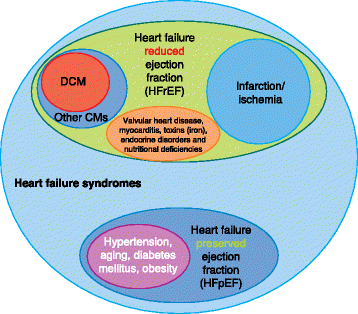Genetics and genomics of dilated cardiomyopathy and systolic heart failure
- PMID: 28228157
- PMCID: PMC5322656
- DOI: 10.1186/s13073-017-0410-8
Genetics and genomics of dilated cardiomyopathy and systolic heart failure
Abstract
Heart failure is a major health burden, affecting 40 million people globally. One of the main causes of systolic heart failure is dilated cardiomyopathy (DCM), the leading global indication for heart transplantation. Our understanding of the genetic basis of both DCM and systolic heart failure has improved in recent years with the application of next-generation sequencing and genome-wide association studies (GWAS). This has enabled rapid sequencing at scale, leading to the discovery of many novel rare variants in DCM and of common variants in both systolic heart failure and DCM. Identifying rare and common genetic variants contributing to systolic heart failure has been challenging given its diverse and multiple etiologies. DCM, however, although rarer, is a reasonably specific and well-defined condition, leading to the identification of many rare genetic variants. Truncating variants in titin represent the single largest genetic cause of DCM. Here, we review the progress and challenges in the detection of rare and common variants in DCM and systolic heart failure, and the particular challenges in accurate and informed variant interpretation, and in understanding the effects of these variants. We also discuss how our increasing genetic knowledge is changing clinical management. Harnessing genetic data and translating it to improve risk stratification and the development of novel therapeutics represents a major challenge and unmet critical need for patients with heart failure and their families.
Figures

References
-
- The International Society for Heart and Lung Transplantation. International Society of Heart and Lung Transplantation Quarterly Report. 2015 edition.
-
- Maron BJ, Towbin JA, Thiene G, Antzelevitch C, Corrado D, Arnett D, et al. Contemporary definitions and classification of the cardiomyopathies: an American Heart Association Scientific Statement from the Council on Clinical Cardiology, Heart Failure and Transplantation Committee; Quality of Care and Outcomes Research and Functional Genomics and Translational Biology Interdisciplinary Working Groups; and Council on Epidemiology and Prevention. Circulation. 2006;113:1807–16. doi: 10.1161/CIRCULATIONAHA.106.174287. - DOI - PubMed
-
- Elliott P, Andersson B, Arbustini E, Bilinska Z, Cecchi F, Charron P, et al. Classification of the cardiomyopathies: a position statement from the European Society Of Cardiology Working Group on Myocardial and Pericardial Diseases. Eur Heart J. 2008;29:270–6. doi: 10.1093/eurheartj/ehm342. - DOI - PubMed
Publication types
MeSH terms
Grants and funding
LinkOut - more resources
Full Text Sources
Other Literature Sources
Medical

